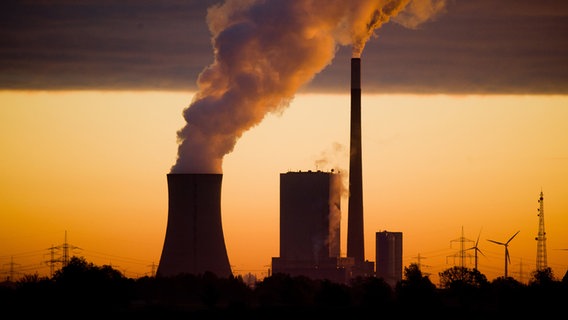Status: 08/23/2023 09:18 a.m
The measures to combat climate change are not enough: by 2030, Germany will emit 331 million tonnes more carbon dioxide than the government’s climate target, which is too unambitious anyway. That shows a recently published report.
In 2030, Germany wants to emit 65 percent less carbon dioxide (CO2) than in 1990. It was laid down in the Climate Protection Act. This goal will probably be just reached, but on the way there too much CO2 will be emitted in the coming years. That puts it recently published with a delay of months Projection Report 2023 on future greenhouse gas emissions, which was commissioned by the Federal Environment Agency (UBA). The climate protection measures adopted by the end of August last year are therefore not sufficient to reduce emissions far enough by 2030. Even the federal government’s current draft for a climate protection program with around 130 measures is not sufficient, according to the Expert Council for Climate Issues in its recently published statement.
331 million tons of CO2 too much by 2030
If you add up how much CO2 will be emitted in Germany from 2023 to 2030 according to the model calculation in the projection report, then there is a total climate protection gap of 331 million tons. “331 million tons are already significant,” said a spokeswoman for the UBA. “The total gap by 2030 is more than 40 percent of our current annual emissions. Further measures are needed to save that.”
Expert advice: climate protection gap even larger
If you add the climate protection measures that were planned but not yet decided by the end of August last year, then Germany will almost achieve its own climate target of 65 percent reduction in 2030, but the total will increase in the years before still emit 194 million tons of greenhouse gases too much, according to the projection report. And the gap to the goal laid down in the Climate Protection Act will be even larger, said the chairman of the Expert Council for Climate Issues (ERK), Professor Hans-Martin Henning. Because the assumptions made at the time of modeling are no longer valid, for example because plans for the Building Energy Act have been changed or it is questionable whether the expansion of renewable energies is progressing at the assumed pace.
Environmental aid complains about “breaking the law” of the climate protection law
“A breach of the law,” said Barbara Metz, federal director of the German Environmental Aid, the failure to meet the climate targets in an interview on Phönix. And the deputy chairwoman of the ERK, Brigitte Knopf, is missing an overall government concept with monitoring and controlling to make visible the exact effects of the individual climate protection measures and whether the climate goals are being achieved.
Even the climate target is not in the green zone
The climate protection target set by the government for 2030 is not even enough to keep global warming below 1.5 degrees, as almost all countries agreed to in Paris in 2015. This is shown by data from the so-called Climate Action Tracker (CAT). They illustrate how German CO2 emissions would have to be reduced so that global warming is likely to be kept below 1.5 degrees (green area of the graphic), below 2 degrees (yellow) or below 3 degrees (orange) – assuming all countries perform pro residents the same contribution.
As the graphic shows, not only are the emissions in 2022 in the yellow area, but also the climate protection target for 2030 itself. “Germany is on the way to +2 degrees average global warming,” said Hanna Fekete from the NewClimate Institute, which together with created the Climate Action Tracker for another non-profit institute. “The goal is not enough. And the measures that have been decided on are even more insufficient because we won’t achieve the goal with them,” says Fekete.
CO2 emissions: Germany must do more to ensure fair distribution
In terms of fair distribution, even the green area is not enough – and Germany should do even more. Because in Paris it was agreed that countries like Germany should contribute more to climate protection because they have a high economic power and have emitted significantly more than the average of the other countries since the beginning of industrialization. For a fair, appropriate contribution, German CO2 emissions would have to be reduced to zero by 2031, says one Analysis of the Advisory Council for Environmental Issues. And according to Climate Action Tracker, if the necessary efforts were distributed fairly, German emissions would even have to be well below zero in purely mathematical terms by 2030 – for example by planting more trees, renaturing moors and financing climate protection projects abroad.
Transport, buildings, energy: which sector needs to reduce CO2 by how much?
Nevertheless, the government has its climate goals in its Proposal for the revision of the Climate Protection Act from last June not tightened. And the individual sectors such as industry, transport or agriculture should in future be held less responsible if they miss their target. A look at the individual sectors is revealing. It shows, for example, how important speed is in the energy transition in order to achieve a 77 percent reduction in the area with the most CO2 emissions by 2030 compared to 1990.
The areas of transport and buildings are particularly negative, because both exceeded their maximum permitted level of emissions in 2022. This is the case in the transport sector for the second time in a row – and the responsible ministry has still not submitted an emergency program, although it would be obliged to do so within three months according to the previous climate protection law. Even in the optimistic scenario of the projection report, the transport sector clearly misses its climate target: by 187 million tons (cumulated up to 2030). But without further climate protection measures, the building and industry sectors will also exceed the permitted maximum amounts of greenhouse gas emissions.
Expert council criticizes unclear data basis of the federal government
“The measures specified in the climate protection program do not meet the requirements of an immediate program,” made clear the chairman of the ERK, Professor Hans-Martin Henning. His deputy, Brigitte Knopf, criticized the different figures presented by various ministries. She compared the federal government’s data with a 1000-piece puzzle, which, however, contained pieces from three different puzzles. The ERK has problems evaluating the climate protection program, said Knopf.
Speed limit could avoid 6.7 million tons of CO2
For Hanna Fekete from the NewClimate Institute, it is “painful” to see that even simple measures such as a speed limit on freeways are not being enforced. Even the majority of ADAC members are according to a recent survey meanwhile for it – and according to UBA it would save 6.7 million tons of CO2 per year.
However, according to Fekete, the implementation of simple savings alone is no longer enough: “We should have done that 20 years ago.” Now a big package is needed, a profound transformation.
Compliance with the 2030 climate targets still possible
It is still possible to achieve the German climate protection targets by 2030 in all sectors – this is shown by what was published at the beginning of July Climate protection instruments scenario 2030 (KIS-2030) on behalf of the UBA. A large number of climate protection measures – including more rail transport, a reform of the motor vehicle tax and the restriction of fossil fuel heating – would make it possible to reduce emissions by 68 percent compared to 1990.
Further information









